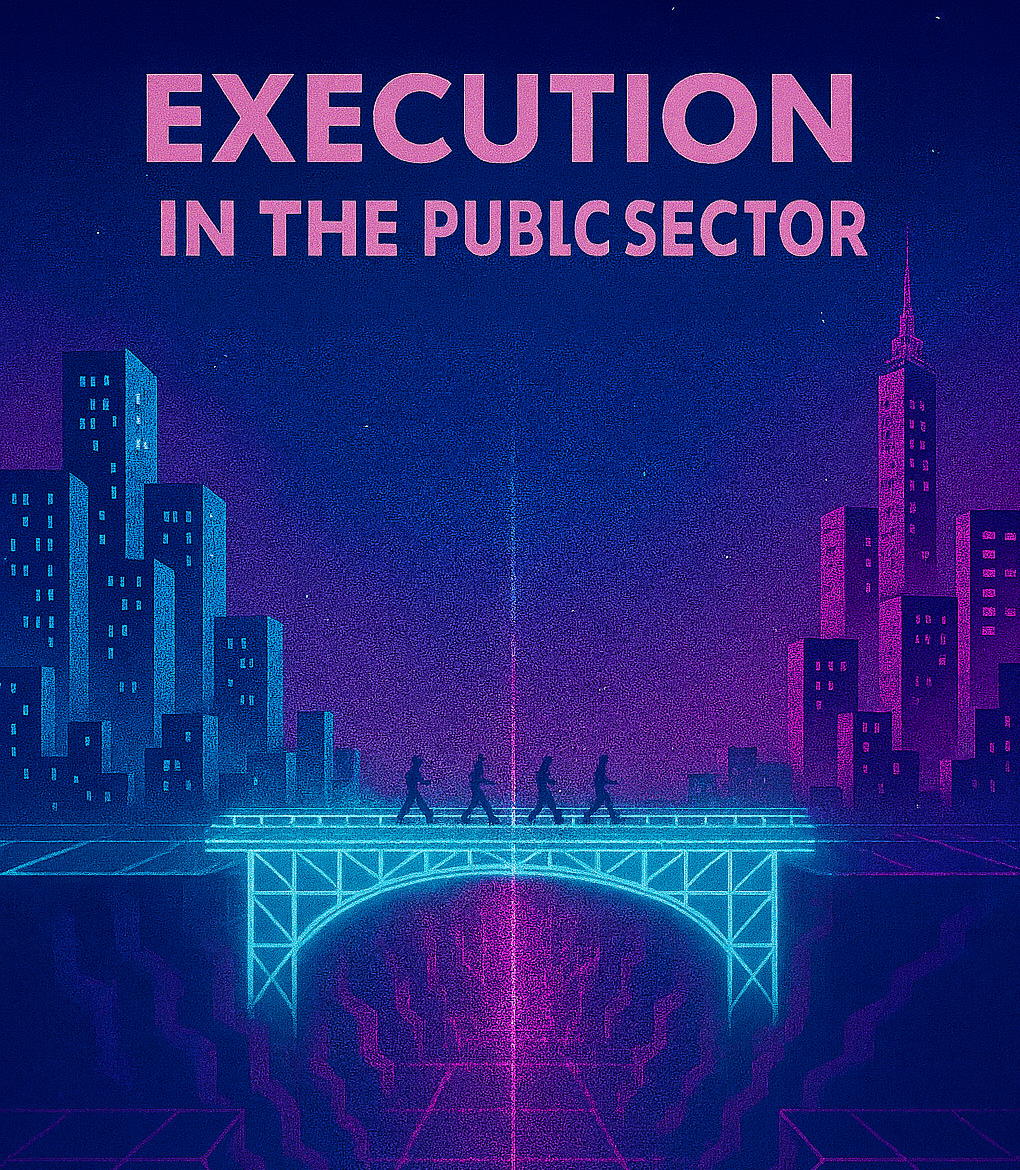Execution in the Public Sector: Building Momentum Within Constraints

Progress in government never looks like the glossy slides that promise transformation.
It moves slower, quieter, and if you are paying attention...deeper.
The public sector doesn’t fail for lack of vision. It struggles because execution lives in the narrow space between regulation and responsibility.
You’re trying to innovate while protecting trust. You’re steering change through rules designed to prevent risk, not accelerate it.
The Misunderstood Pace
We like to call government “slow,” but that’s the wrong word.
What looks like hesitation is often stewardship.
Procurement cycles, compliance reviews, public comment periods: they exist because public money and public confidence are on the line.
As Stephen Goldsmith once wrote, “In government, the absence of failure too often masquerades as success.” (Goldsmith & Kleiman, 2017).
Speed without accountability isn’t progress; it's the powderkeg of politics waiting to explode.
Real execution in the public sector means moving deliberately enough that trust can keep up.
The Weight of Trust
Every digital initiative in government is a trust exercise.
- A benefits portal that remembers your information.
- A data dashboard that tells the truth even when it’s inconvenient.
- A permit system that doesn’t crash.
Gartner (2022) reminded leaders that “citizens judge government by their last digital experience.”
If their last interaction was seamless; whetehr it was a a bank app, a rideshare, or an online order.
they expect the same from their city or agency.
That’s the paradox of public innovation: people expect private-sector speed delivered with public-sector integrity.
Execution happens when technology earns that trust one transaction at a time.
Momentum Inside Constraint
During my time in local government, I learned that progress doesn’t always announce itself.
It happens in pilot programs and cross-department conversations.
In one city, a small GIS team integrated three data sources that had never spoken before. It didn’t make headlines, but it cut inspection times in half.
That’s execution.
It’s the quiet rhythm of change: one success, shared transparently, becoming proof that more is possible.
OECD (2024) later captured that spirit perfectly: “Digital government is not a technological project; it is a cultural transformation of the public sector itself.”
Culture moves through stories of what worked.
And not mandates about what should.
What Execution Looks Like When It Works
Governments that sustain transformation share three traits:
- They start visible but manageable.
Every win, no matter how small, is public and shared. Visibility builds permission for the next step. - They design for reuse.
One platform, one data model, one authentication pattern becomes the foundation for ten more projects.
Deloitte (2023) called this shift “from projects to platforms,” where investments compound instead of expire. - They reward stewardship.
The leaders who maintain momentum rarely seek credit; they seek continuity. McKinsey (2024) described them as “architects of resilience”—leaders who make progress repeatable, not just remarkable.
Execution in the public sector is all about durability, not disruption.
The Rhythm of Real Change
Public transformation thrives on rhythm, not revolution.
Weekly stand-ups become rituals of accountability.
Procurement becomes partnership.
Small teams iterate under the radar until the risk feels safe enough to scale.
And when the wins stack up; when staff start asking “What’s next?” instead of “Why are we doing this?”
...you know execution has turned into culture.
Lessons for Any Sector
Even now, working in manufacturing and enterprise analytics, I see the same truth play out.
- Constraints clarify what innovation can can occur, not stifle it.
- Every organization has its version of red tape, whether that is budget, compliance, or technical debt.
But the teams that move forward are the ones that see constraint as design, not defeat.
They ask, “What can we build within the rules?” rather than waiting for permission to break them.
That's the mindset earned in my locality; has shaped how I approach transformation anywhere.
The Leadership Challenge
The best public-sector leaders don’t just deliver programs; they deliver belief.
They remind teams that small progress isn’t failure; it’s evidence that change is working.
As Drucker (1999) wrote, “Plans are only good intentions unless they immediately degenerate into hard work.”
Execution is that hard work—consistent, transparent, grounded in the mission.
It’s how policy becomes service. How vision becomes infrastructure. And how technology stops being the afterthought and becomes the enabler of trust.
Bridging Forward
In the private sector, partnerships often accelerate change.
In government, partnerships enable it: between the agencies, vendors, and civic organizations.
That’s where we’ll go next: how service providers can become strategic allies, not contractors.
Because bridging the divide isn’t just about technology; it’s about the relationships that turn progress into permanence.
References
- Deloitte. (2023). Tech Trends 2023: Government and the digital frontier. Deloitte Insights. https://www2.deloitte.com/
- Drucker, P. F. (1999). Management challenges for the 21st century. HarperBusiness.
- Gartner. (2022). The future of digital government: From modernization to mission enablement. Gartner Research.
- Goldsmith, S., & Kleiman, M. (2017). Innovating government: Reforming the public sector through technology. Harvard Kennedy School Press.
- McKinsey & Company. (2024). The state of organizations 2024: Ten shifts transforming organizations. McKinsey Insights.
- Organisation for Economic Co-operation and Development (OECD). (2024). Digital government review: Building citizen-centric digital transformation. OECD Publishing. https://www.oecd.org/